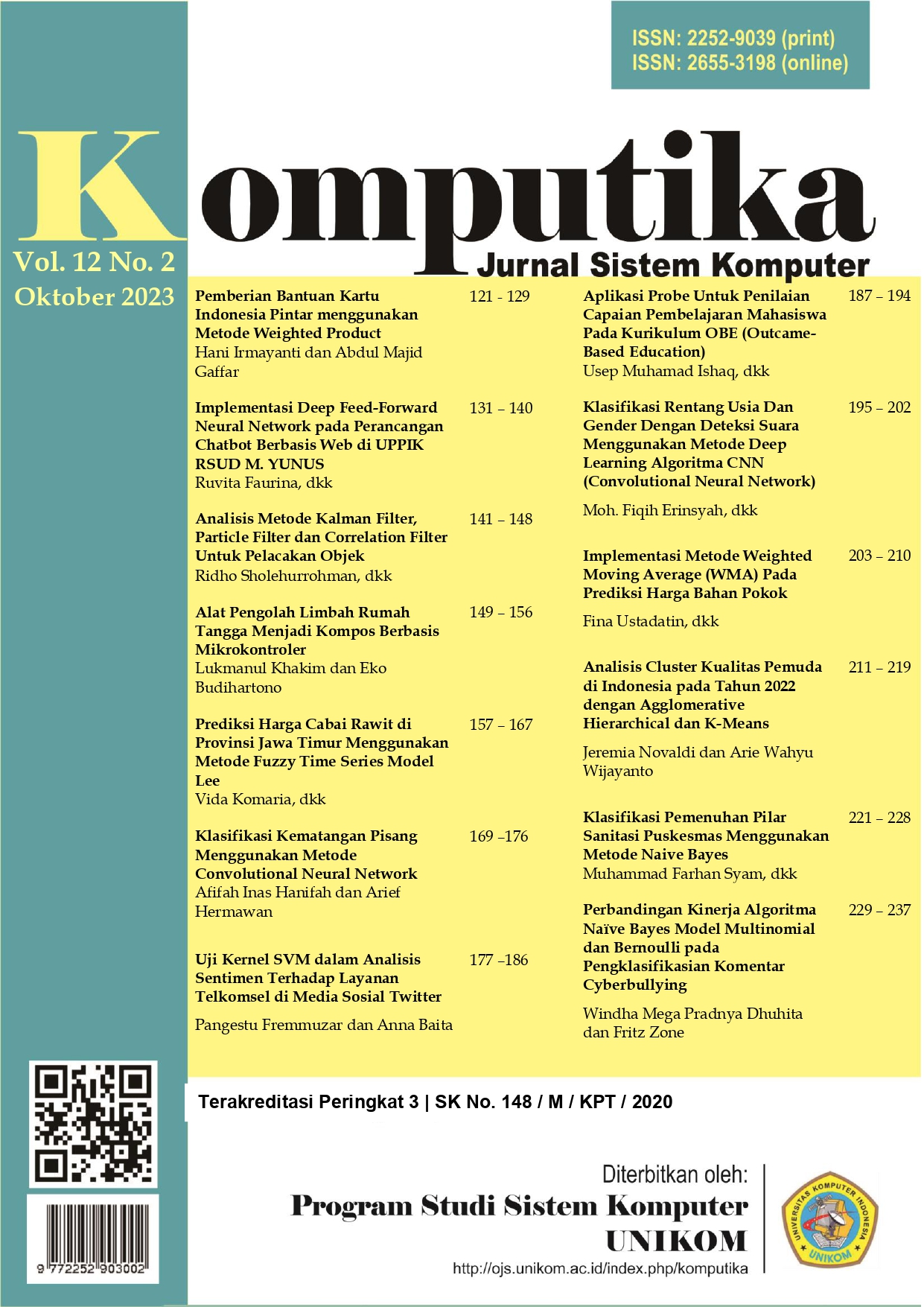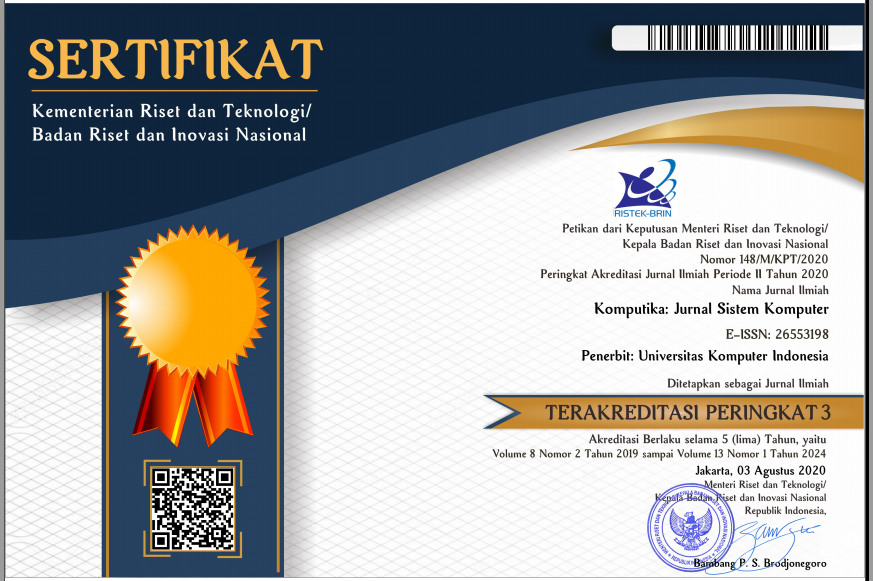Implementasi Deep Feed-Forward Neural Network pada Perancangan Chatbot Berbasis Web di UPPIK RSUD M. YUNUS
DOI:
https://doi.org/10.34010/komputika.v12i2.8914Abstract
ABSTRACT – The UPPIK (Customer Information and Counseling Complaint Unit) at the M. Yunus Hospital has an important role in serving visitors who come to the hospital. However, visitors often complain about the UPPIK service due to limited working hours, so there is not always staff available to provide the information needed by visitors. In addition, the ongoing Covid-19 pandemic requires people to maintain distance and reduce interaction with others. To solve this problem, an automatic chatbot has been developed to provide service as if the visitor is speaking directly to the staff without any time constraints. This research uses a Deep Feed-Forward Neural Network algorithm. The dataset used is a collection of question-answer data collected through direct observation at the UPPIK, consisting of 1464 pairs of data. The best accuracy was obtained by spliting the dataset into 80% training data (1,185 data), 10% testing data (147 data), and 10% validation data (132 data) with 300 epochs, which resulted in an accuracy of 91.98%. Evaluation of these results showed a precision value of 0.99, a recall value of 0.98, and an f1-score of 0.99.
Keywords - UPPIK RSUD M. Yunus Bengkulu; Artificial Intelligence; Chatbot; Deep Feed-Forward Neural Network; Deep Learning
References
S. Sudianto, A. D. Sripamuji, I. Ramadhanti, R. R. Amalia, J. Saputra, dan B. Prihatnowo, “Penerapan Algoritma Support Vector Machine dan Multi-Layer Perceptron pada Klasisifikasi Topik Berita,” vol. 11, no. 2, hal. 84–91, 2022.
Mahardhika Chandra, Rizki Pratama, Fathan Azka Pradana, dan Alvita Bonita, “Chatbot Interaksi Rumah Sakit menggunakan FFNN,” Indones. J. Data Sci., vol. 3, no. 1, hal. 62–68, 2022, doi: 10.56705/ijodas.v3i1.36.
R. P. Putra, A. H. Pratomo, R. I. Perwira, U. Pembangunan, N. Veteran, dan I. Artikel, “Text Message Classification using Multiclass Support Vector Machine on Information Service Chatbot in the Informatics Department UPN ‘ Veteran ’ Yogyakarta,” vol. 19, no. 3, hal. 295–310, 2022, doi: 10.31515/telematika.v19i3.7418.
K. A. Nugraha dan D. Sebastian, “Chatbot Layanan Akademik Menggunakan K-Nearest Neighbor,” J. Sains dan Inform., vol. 7, no. 1, hal. 11–19, 2021, doi: 10.34128/jsi.v7i1.285.
N. Bhartiya, N. Jangid, S. Jannu, P. Shukla, dan R. Chapaneri, “Artificial Neural Network Based University Chatbot System,” 2019 IEEE Bombay Sect. Signat. Conf. IBSSC 2019, vol. 2019Januar, hal. 1–6, 2019, doi: 10.1109/IBSSC47189.2019.8973095.
N. A. Purwitasari dan M. Soleh, “Implementasi Algoritma Artificial Neural Network Dalam Pembuatan Chatbot Menggunakan Pendekatan Natural Language Parocessing,” J. IPTEK, vol. 6, no. 1, hal. 14–21, 2022, doi: 10.31543/jii.v6i1.192.
D. A. C. Rachman, R. Goejantoro, dan F. D. T. Amijaya, “Implementasi Text Mining Pengelompokkan Dokumen Skripsi Menggunakan Metode K-Means Clustering,” J. EKSPONENSIAL, vol. 11, no. 2, hal. 167–174, 2020.
J. Zhang, J. Zhang, S. Ma, J. Yang, dan G. Gui, “Chatbot design method using hybrid word vector expression model based on real telemarketing data,” KSII Trans. Internet Inf. Syst., vol. 14, no. 4, hal. 1400–1418, 2020, doi: 10.3837/TIIS.2020.04.001.
“View of PENGGALIAN TEKS DENGAN MODEL BAG OF WORDS TERHADAP DATA TWITTER.pdf.”
A. F. Agarap, “Deep Learning using Rectified Linear Units (ReLU),” no. 1, hal. 2–8, 2018, [Daring]. Tersedia pada: http://arxiv.org/abs/1803.08375
P. Muangkammuen, N. Intiruk, dan K. R. Saikaew, “Automated Thai-FAQ chatbot using RNN-LSTM,” 2018 22nd Int. Comput. Sci. Eng. Conf. ICSEC 2018, hal. 1–4, 2018, doi: 10.1109/ICSEC.2018.8712781.
M. Read Pablo Rivas, F. Advisor, dan M. Read, “Deployment and Hyper-Parameter Optimization of Chatbots,” 2019.
P. Algoritma dan B. Moore, “Penerapan algoritma boyer moore pada chatbot ustaz abdul somad,” 2021.
J. Homepage, Y. Saputra Wijaya, F. Zoromi Informatic, dan S. Amik Riau, “JAIA-Journal Of Artificial Intelligence And Applications Chatbot Designing Information Service for New Student Registration Based on AIML and Machine Learning,” JAIA-Journal Artif. Intell. Appl., vol. 1, no. 1, hal. 1–10, 2020.
I. W. Saputro dan B. W. Sari, “Uji Performa Algoritma Naïve Bayes untuk Prediksi Masa Studi Mahasiswa,” Creat. Inf. Technol. J., vol. 6, no. 1, hal. 1, 2020, doi: 10.24076/citec.2019v6i1.178.
Karsito dan S. Susanti, “Klasifikasi Kelayakan Peserta Pengajuan Kredit Rumah Dengan Algoritma Naïve Bayes Di Perumahan Azzura Residencia,” J. Teknol. Pelita Bangsa, vol. 9, hal. 43–48, 2019.
S. Sultan, A. Issa, dan R. Bayu, “Pengembangan Chatbot Yanies Cookies Untuk Pemesanan Kue Kering Berbasis Dialogflow,” J. Pengemb. Teknol. Inf. dan Ilmu Komput. Univ. Brawijaya, vol. 4, no. 7, hal. 2121–2129, 2020.



















